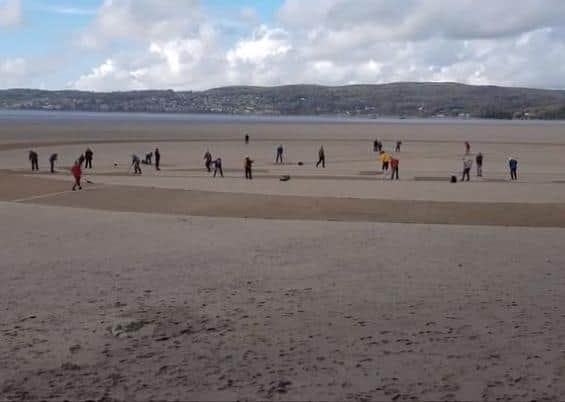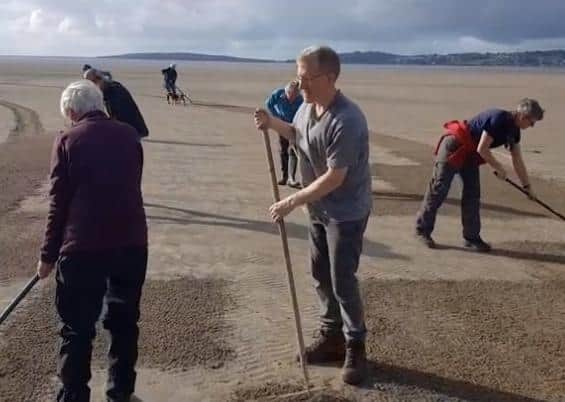Giant Extinction Rebellion logo appears on beach in Morecambe Bay


Around fifty people, aged seven to 70, took part in the event on the sands near Arnside to highlight the need for urgent action on climate change and biodiversity loss.
Lancaster based sand artist Paul Speight said he was unable to attend the recent Extinction Rebellion (XR) action in London, but still wanted to support the people who did.
Advertisement
Hide AdAdvertisement
Hide AdHe chose White Creek Bay near Arnside as the location for the 110m diameter logo representation, and the whole event was captured on film by Lancaster film-maker Finley Clifton and drone operator and photographer Michael Swarbrick.


Paul said: “It seemed a fitting place to draw the XR logo because of its ecological importance for seabirds and other wildlife, which are put at risk by warmer seas, pollution and ocean acidification, and also because coastal communities are on the frontline of climate change.
“I worried about the idea being frivolous when good people were risking their liberty and even their safety, but for XR to succeed, this issue must become front and centre in people’s minds and so it needs promoting in all areas of life including art and culture.
“A good start is to help make the symbol as widely recognised as the peace symbol is.”
Advertisement
Hide AdAdvertisement
Hide AdAn online video called Every Single Being On the Planet has now been released online, capturing the events of the day.


Paul said he was reassured by the level of interest and involvement during the event.
He had appealed for people to help create the artwork by raking the sand, hoping at least a dozen would come.
In the end around 50 people took part, bringing their own rakes, and the piece was completed in under four hours, with time to spare before the sea returned to wash it away.
Advertisement
Hide AdAdvertisement
Hide AdMany of the helpers were supporting XR for the first time and said they would now feel able to do so again.
Paul said: “My thoughts about climate change had become very dark over the last decade or more because I had increasingly focussed on the ‘how’ of societal collapse rather than the ‘if or when’.
“If we do still have time to make a significant and positive change – and I really struggle to feel we do - it is only by coming together to work for that change.
“We have to resist feelings of cynicism or resignation and that is more easily achieved when we feel inspired by the presence and commitment of other people.”
Advertisement
Hide AdAdvertisement
Hide AdPaul used simple and ancient tools - wooden sticks, a length of rope and an old hoe - to set out the outline of the extinction symbol, which contains an hour glass within a circle, representing how time is running out for many species and that our own future on the planet is at risk.
He added: “Sand art is also transitory and so a fitting way to remind people of our potentially transitory state as the damage we are doing in our short lives is creating a sixth mass extinction: if we don’t act now we will have done irreversible damage to the planet.”
Paul said that as the largest expanse of intertidal mudflats and sand in the UK, Morecambe Bay provided the perfect canvas to create the logo.
The event was captured on film with stunning drone footage, and has been made into a film called Every Single Being on the Planet. The film is available via social media and on Youtube.
Advertisement
Hide AdAdvertisement
Hide AdDuring the course of the day, an idea was hatched to make this event a springboard for an international action involving sand art, which could result in the XR symbol appearing on beaches across the world next spring.